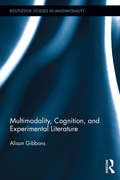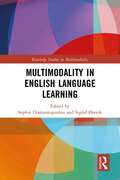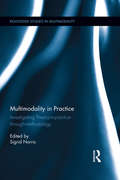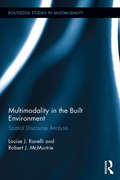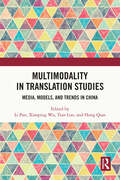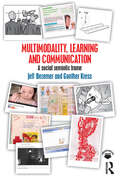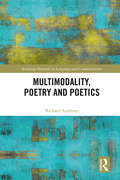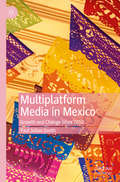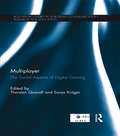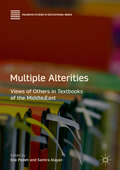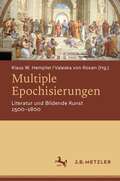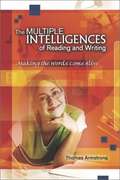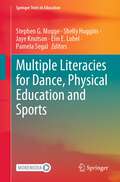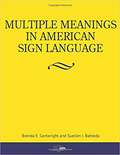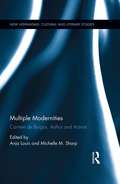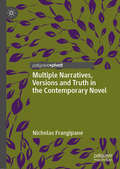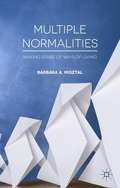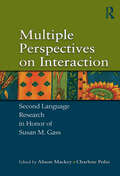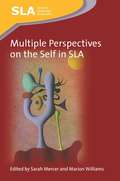- Table View
- List View
Multimodality, Cognition, and Experimental Literature (Routledge Studies in Multimodality)
by Alison GibbonsSince the turn of the millennium, there has seen an increase in the inclusion of typography, graphics and illustration in fiction. This book engages with visual and multimodal devices in twenty-first century literature, exploring canonical authors like Mark Z. Danielewski and Jonathan Safran Foer alongside experimental fringe writers such as Steve Tomasula, to uncover an embodied textual aesthetics in the information age. Bringing together multimodality and cognition in an innovative study of how readers engage with challenging literature, this book makes a significant contribution to the debates surrounding multimodal design and multimodal reading. Drawing on cognitive linguistics, cognitive psychology, neuroscience, semiotics, visual perception, visual communication, and multimodal analysis, Gibbons provides a sophisticated set of critical tools for analysing the cognitive impact of multimodal literature.
Multimodality, Digitalization and Cognitivity in Communication and Pedagogy (Numanities - Arts and Humanities in Progress #20)
by Natalya V. Sukhova Tatiana Dubrovskaya Yulia A. LobinaThis book positions itself at the intersection of the key areas of the modern humanities. Different authors from a variety of countries take innovative approaches to investigating multimodal communication, adapting pedagogical design to digital environments and enhancing cognitive skills through transformations in teaching and learning practices. The eclectic forms under study require eclectic approaches and methodologies, and the authors cross disciplinary boundaries drawing on philosophy, linguistics, semiotics, computational linguistics, mathematics, cognitive studies and neuroaesthetics. Part I presents methods of analysing multimodal communication in its different displays, covering promotional video in crowdfunding project presentations, multimodal public signs of prohibition and visuals as arguments. Part II explores varied teaching methodologies that have emerged as a result of and in response to modern technological changes and contains some practical hints for educators. It demonstrates the pedagogical potential of video games, virtual worlds, linguistic corpora and online dictionaries. Part III focuses on psychological and cognitive factors influencing success in the classroom, primarily, ways of developing students’ and teachers’ personalities. The volume sits at the intersection between Communication Studies, Digital Humanities, Discourse Analysis, Education Theory and Cognitive Studies and is useful to scholars and students of communication, languages, education and other areas of the humanities. This book should trigger scholarly discussions as well as stimulating practitioners’ interest in these fields.
Multimodality in English Language Learning (Routledge Studies in Multimodality)
by Sophia DiamantopoulouThis edited volume provides research-based knowledge on the use, production and assessment of multimodal texts in the teaching and learning of English as an Additional Language (EAL). The book reflects growing interest in research on EAL, with increasing numbers of learners of English worldwide and the growing relevance of EAL to numerous education systems. The volume examines different aspects of English from a multimodal perspective, showcasing empirical research from across five continents and all three levels of education. Applying frameworks based on Multimodal Social Semiotics and Systemic Functional Linguistics, chapters focus on the use and affordances of multimodal texts in pedagogy, literature, culture, text production, assessment and curriculum development connected to EAL. Directing attention to the significance of modes beyond speech and writing in EAL, the volume provides a wide range of perspectives and experiences that can be applied more widely and inspire other practices in the global and diverse field of EAL teaching, learning and assessment. This collection will be of interest to scholars in multimodality, language education, and teacher education.
Multimodality in Practice: Investigating Theory-in-Practice-through-Methodology (Routledge Studies in Multimodality)
by Sigrid NorrisIn this wide-ranging collection, leading scholars, researchers, and emergent researchers from around the world come together and present examples of multimodal discourse analysis in practice. The book illustrates new theoretical, methodological and empirical research into new technologies such as the internet, software, CD-ROM, video, and older technologies such as film, newspapers, brands or billboards. Each chapter demonstrates how aspects of multimodal theory and method can be used to conduct research into these and other multimodal texts. Taken together, the book advances the field of multimodal discourse analysis and offers a range of current studies that address some of the most important questions facing researchers and students when investigating new or old technologies multimodally in linguistics, education, communication studies, sociology, anthropology and other fields.
Multimodality in the Built Environment: Spatial Discourse Analysis (Routledge Studies in Multimodality)
by Louise J. Ravelli Robert J. McmurtrieThis book provides an extended exploration of the multimodal analysis of spatial (three-dimensional) texts of the built environment, culminating in a holistic approach termed Spatial Discourse Analysis (SpDA). Based on existing frameworks frameworks of multimodal analysis, this book applies, adapts, and extends these frameworks to spatial texts. The authors argue that choices in spatial design create meanings about what we perceive and how we can or should behave, influence how we feel in and about those spaces, and enable these texts to function as coherent wholes. Importantly, a spatial text, once built, is also a resource which is then used, and an essential aspect of understanding these texts is to consider what users themselves contribute to the meaning potential of these texts. The book takes the metafunctional approach familiar from Systemic-Functional Linguistics (SFL) and foregrounds each metafunction in turn (textual, interpersonal, experiential, and logical), in relation to the detailed analysis of a particular spatial text.
Multimodality in Translation Studies: Media, Models, and Trends in China
by Li Pan Xiaoping Wu Tian Luo Hong QianFocusing on multimodality in translation studies, this edited volume provides insights into the trends and practices of multimodal translation in a variety of media. Divided into four main themes, the book explores audiovisual translation in digital media, multimodal translation of Chinese classics, multimodal design in website translation, and the use of paratexts in conference interpreting. Contributors draw on a diverse range of methods and theoretical models, including systemic functional multimodal discourse analysis, narrative theory, Skopos-functional theory, multimodal analysis of digital discourse, and corpus-based multimodal analysis. It covers important topics in media translation, ranging from emerging multimodal translation models to multimodal creativity in interlingual subtitling for social media and identity construction in the multimodal translation of food advertising. Through robust empirical studies, the book aims to shed light on the methodological development of multimodal translation in different media forms, including social media, websites, on-site interactions and books. The title will be of great value to scholars and students of linguistics, translation studies, multimodal discourse analysis and digital media.
Multimodality, Learning and Communication: A social semiotic frame
by Gunther Kress Jeff BezemerThis state-of-the-art account of research and theorizing brings together multimodality, learning and communication through detailed analyses of signmakers and their meaning-making in museums, hospitals, schools and the home environment. By analyzing video recordings, photographs, screenshots and print materials, Jeff Bezemer and Gunther Kress go well beyond the comfortable domains of traditional sites of (social) semiotic and multimodal research. They steer away from spurious invention and naming of ever more new and exciting domains, focusing instead on fundamentals in assembling a set of tools for current tasks: namely, describing and analyzing learning and communication in the contemporary world as one integrated field. The theory outlined in the book is grounded in the findings of the authors' wide-ranging empirical investigations. Each chapter evaluates the work that is being done and has been done, challenging accepted wisdom and standing much of it on its head. With extensive illustrations and many examples presented to show the reach and applicability of the theory, this book is essential reading for all those working in multimodality, semiotics, applied linguistics and related areas. Images from the book are also available to view online at www.routledge.com/9780415709620/
Multimodality, Poetry and Poetics (Routledge Research in Language and Communication)
by Richard AndrewsThis groundbreaking work takes multimodality studies in a new direction by applying multimodal approaches to the study of poetry and poetics. The book examines poetry’s visual and formal dimensions, applying framing theory to such case studies as Aristotle’s Poetics and Robert Lowell’s "The Heavenly Rain", to demonstrate both the implied, due to the form’s unique relationship with structure, imagery, and rhythm, and explicit forms of multimodality at work, an otherwise little-explored research strand of multimodality studies. The volume explores the theoretical implications of a multimodal approach to poetry and poetics to other art forms and fields of study, making this essential reading for students and scholars working at the intersection of language and communication, including multimodality, discourse analysis, and interdisciplinary literary studies.
Multimodality Studies in International Contexts: Contemporary Trends and Challenges (Routledge Studies in Multimodality)
by Liliana Vásquez RoccaThis collection responds to the need for theoretically informed and methodologically grounded empirical research on the global transformations in multimodal human communication and social practices in light of recent widespread change. The volume highlights the need to expand on the established approaches--Social Semiotics, Multimodal Discourse Analysis, and Multimodal (Inter)action Analysis--by complementing them with other analytical frameworks to better understand the impact of unprecedented global challenges, such as Covid-19, on the way humans communicate and make use of meaning-making resources. Bringing together established and emergent scholars from a variety of geographical, cultural, and linguistic contexts, the collection presents studies from both the Global North and Global South, including South Africa, Latin America, Brazil, and the Caribbean, to showcase new perspectives in multimodality research. This innovative book will be of interest to students and scholars in multimodality, social semiotics, and discourse analysis.
Multiplatform Media in Mexico: Growth and Change Since 2010
by Paul Julian SmithMultiplatform Media in Mexico is the first book to treat the exciting, interconnected fields of cinema, television, and internet in Mexico over the last decade, fields that combine to be called multiplatform media. Combining industrial analysis of a major audiovisual field at a time of growth and change with close readings of significant texts on all screens, acclaimed author Paul Julian Smith deftly details these new audiovisual trends. The book includes perspectives on local reporting on the ground, as covered in the chapter documenting media response to the 2017 earthquake. And, for the first time in this field, the book draws throughout on star studies, tracing the distinct profiles of actors who migrate from one medium to another. As a whole, Smith’s analyses illustrate the key movements in screen media in one of the world’s largest media and cultural producing nations. These perspectives connect to and enrich scholarship across Latin American, North American, and global cases.
Multiplayer: The Social Aspects of Digital Gaming (Routledge Studies in European Communication Research and Education)
by Thorsten Quandt Sonja KrögerIn the past decade, digital games have become a widely accepted form of media entertainment, moving from the traditional 'core gamer' community into the mainstream media market. With millions of people now enjoying gaming as interactive entertainment there has been a huge increase in interest in social multiplayer gaming activities. However, despite the explosive growth in the field over the past decade, many aspects of social gaming still remain unexplored, especially from a media and communication studies perspective. Multiplayer: Social Aspects of Digital Gaming is the first edited volume of its kind that takes a closer look at the various forms of human interaction in and around digital games, providing an overview of debates, past and present. The book is divided into five sections that explore the following areas: Social Aspects of Digital Gaming Social Interactions in Virtual Worlds Online Gaming Co-located and Console Gaming Risks and Challenges of Social Gaming This engaging interdisciplinary book will appeal to upper level students, postgrads and researchers in games research, specifically those focusing on new media and digital games, as well as researchers in media studies and mass communication.
Multiple Access Communications
by Tatiana K. Madsen Jimmy J. Nielsen Nuno K. PratasThis book constitutes the proceedings of the 9th International Workshop on Multiple Access Communications, MACOM 2016, held in Aalborg, Denmark, in November 2016. The 10 full papers presented in this volume were carefully reviewed and selected from 12 submissions. They were organized in topical sections named: physical layer aspects; MAC layer aspects; and information theory.
Multiple Alterities
by Elie Podeh Samira AlayanThis book highlights and examines the role of the textbook in legitimising established political and social orders. It analyses the way in which the 'other' is presented in school textbooks, focusing on a number of countries in the Middle East and North Africa (MENA) region, and argues that the role of textbooks in developing and maintaining a national identity should be afforded greater critical attention. Textbooks can help form national identities by developing a society's collective memory; this might involve a historical narrative which may be self-contradictory or even fabricated to a certain extent, including myths, symbols and collective memories that divide "us" from "them", and ultimately resulting a dichotomy between the Self and the Other. As well as addressing a range of theoretical questions relating to the study of textbooks generally, the volume also covers a broad spectrum of Middle Eastern states and societies, with contributions from Turkey, Iran, Egypt, Cyprus, Lebanon, Iraq, Kurdistan, Jordan, Morocco, Tunisia, Israel and Palestine. It will be essential reading for researchers and students working in the fields of Education, Sociology and History, particularly those with an interest in national identities in the MENA region.
Multiple Choice And Free Response Questions In Preparation For The AP English Language And Composition Examination (5th Edition)
by Richard Vogel Charles F. WinansHelp with language arts
Multiple Choice and Free-Response Questions in Preparation for the AP English Language and Composition Examination (6th Edition)
by Richard VogelThis book has been designed to help students prepare for the Advanced Placement Exam in English Language and Composition. It is not filled with definition of literary terms nor saccharine advice on how to 'psych' students up for the examination. Rather, its passages are selected and its questions designed with the singular purpose of developing in students the habits of mind that good readers possess, that they actively employ while reading, and that they use to structure and develop their written responses to the text.
Multiple Epochisierungen: Literatur und Bildende Kunst 1500–1800
by Klaus W. Hempfer Valeska Von RosenEntgegen einer pauschalen Kritik an den Epochenbegriffen diskutieren die Beiträge des vorliegenden Bandes historische und systematische Bedingungen der Möglichkeit von Epochisierungen. Unterschiedliche sozio-kulturelle Systeme werfen unterschiedliche Fragen auf. Als Literatur- und Kunstwissenschaftler/innen gehen die Beiträgerinnen und Beiträger von Problemkomplexen ihrer jeweiligen Disziplinen aus, rekurrieren für Lösungsansätze aber auch auf das Theorieangebot anderer historischer Disziplinen wie der Geschichtswissenschaft im Allgemeinen oder der Wissenschaftsgeschichte im Besonderen. - Insgesamt ergibt sich, dass die berechtigte Kritik an der spezifischen Faktur spezifischer Epochisierungen weder aus systematischen noch historischen Gründen den generellen Verzicht auf Epochisierungen nahelegt. Solange kein konsistentes Gegenmodell vorliegt, kann es nur darum gehen, Epochentheorie allgemein und Theorien der jeweiligen Einzelepochen im Zusammenhang zu optimieren.
Multiple Genres, Multiple Voices: Teaching Argument in Composition and Literature
by Cheryl L. Johnson Jayne A. MoneysmithStimulate research and genuine intellectual conversation by using the MVA in your teaching. Read Multiple Voices, Multiple Genres and find out why many voices are better than one.
The Multiple Intelligences of Reading and Writing: Making the Words Come Alive
by Thomas ArmstrongShows how using Multiple Intelligences will help students acquire reading and writing skills.
Multiple Literacies for Dance, Physical Education and Sports (Springer Texts in Education)
by Stephen G. Mogge Shelly Huggins Jaye Knutson Elin E. Lobel Pamela SegalThis book explores a spectrum of literacies relevant to dance, physical education and sports. It examines conceptions of movement literacies, disciplinary literacies and traditional school literacies. It includes theory, research and instructional practice related to the uses of traditional print, multimedia, and embodied physical literacies. These literacies function independently but are also overlapping and mutually reinforcing in comprehensive instructional planning. As movement and activity-related fields continue to explore the potential for multiple literacies, this book introduces numerous possibilities, both conceptual and practical, for consideration. · Pre-service and in-service teachers in dance and physical education programs will learn how to integrate multiple literacies in curriculum design and teaching.· Graduate students will examine theoretical premises of movement and disciplinary literacies and become familiar with original research on these topics.· Teachers, school administrators, coaches and athletic directors will use the book in order to guide the inclusion of movement and activity-based fields in the disciplinary literacy agenda now common in Pre-K through secondary schooling. Media rich chapters, including photographic, video and other graphic images, allow students to access concepts through multiple modalities
Multiple Meanings in American Sign Language
by Brenda E. Cartwright Suellen J. BahledaThere are a variety of ways one can use this book to improve one's signing and interpreting skills. Teachers and students may choose to explore one particular unit or a variety of elements from different units. This book assists in developing and practicing a process for analyzing the meaning of specific English words and phrases so that one can create accurate equivalents in ASL. It is crucial that learners avoid the temptation to hurry through any exercise, even when a word or phrase seems easy or obvious. By taking the time to analyze and determine the meanings of the various words and phrases in the exercises within this book, a process for analyzing meaning emerges which serves as a foundation for analyzing the meaning of English words and phrases and translating this meaning accurately, efficiently and proficiently into ASL.
Multiple Modernities: Carmen de Burgos, Author and Activist (New Hispanisms: Cultural and Literary Studies)
by Michelle Sharp Anja LouisThis collection of essays confirms Carmen de Burgos’s pivotal place in Spanish feminist history by bringing together eminent international scholars who offer new readings of Burgos’s work. It includes the analyses of a number of lesser-known texts, both fictional and non-fictional, which give us a more comprehensive examination of Burgos’s multipronge feminist approach. Burgos’s works, especially her essays, are essential feminist reading and complement other European and North American traditions. Gaining familiarity with the breadth and depth of her work serves not only to provide an understanding of Spanish firstwave feminism, but also enriches our appreciation of cultural studies, gender studies, subaltern studies and travel literature. Looking at the entirety of her life and work, and the wide-ranging contributions in this volume, it is evident that Burgos embodied the tensions between tradition and modernity, depicting multiple representations of womanhood. Encouraging women to take ownership of their personal fashion, the design of their homes and the decorum of their families were steps towards recognizing a female population that was cognizant of its own desires.
Multiple Narratives, Versions and Truth in the Contemporary Novel
by Nicholas FrangipaneMultiple Narratives, Versions and Truth in the Contemporary Novel considers the shifting perception of truth in fiction. Nicholas Frangipane examines the narrative technique of telling multiple versions of the same sets of events, presenting both true and false versions of the events within a fictional work. This book looks closely at these “Reflexive Double Narratives” in order to understand the way many contemporary writers have attempted to work past postmodernism without forgetting its lessons. Frangipane explores how writers like Ian McEwan, Yann Martel and Alice Munro have departed from the radical experimentation of their predecessors and instead make sincere attempts to find ways that fictional writing can reveal enduring truths, and in so doing, redefine the meaning of “truth” itself and signal the emergence of post-postmodernism.
Multiple Normalities
by Barbara A. MisztalMultiple Normalities: Making Sense of Ways of Living enhances sociological understandings of normality by illustrating it with the help of British novels. Barbara A. Misztal conceptualizes the notion of normality as the frame through which people see and interpret their particular historical circumstances. Assuming that literature constitutes a kind of knowledge about the experience of the social world which is complementary to sociological knowledge, it investigates the representations ofnormality in prize-winning novels published between 1950 and 1970 and between 1990 and 2010. Multiple Normalities analyzes the novels in terms of how their central images of normality demonstrate commonalities and differences between the meanings of normality in the two different periods, as well as changes in the experience of a sense of normality in the last sixty years. Misztal, by illustrating the emergence of multiple normalities, demonstrates the transformation of ways in which we give meaning to the world.
Multiple Perspectives on Interaction: Second Language Research in Honor of Susan M. Gass
by Alison Mackey Charlene PolioThis volume in honor of Susan M. Gass focuses on interaction in second language acquisition from multiple perspectives. International experts in the field of SLA contribute insights and explanations on the interaction approach's compatibility with other theoretical approaches, key empirical studies, interaction in specific contexts, and future directions. Readers will find an enriching discussion of how the interaction research tradition is viewed in a wide range of different approaches to learning and teaching second languages.
Multiple Perspectives on the Self in SLA
by Marion Williams Sarah MercerInstead of viewing different perspectives on the self as competing with each other and considering one perspective on the self as being inherently 'better' than another, this book takes the view that a fuller, more comprehensive picture of the self in SLA can be gained by examining and combining insights from different perspectives. This original collection of papers thus attempts to provide a thorough overview of the ways in which the self can be conceptualised in SLA contexts. The editors have brought together a diverse range of theoretical perspectives on the self to allow the reader to appreciate the insights that each approach contributes to overall understandings of the self in the domain of second language acquisition and foreign language learning.
